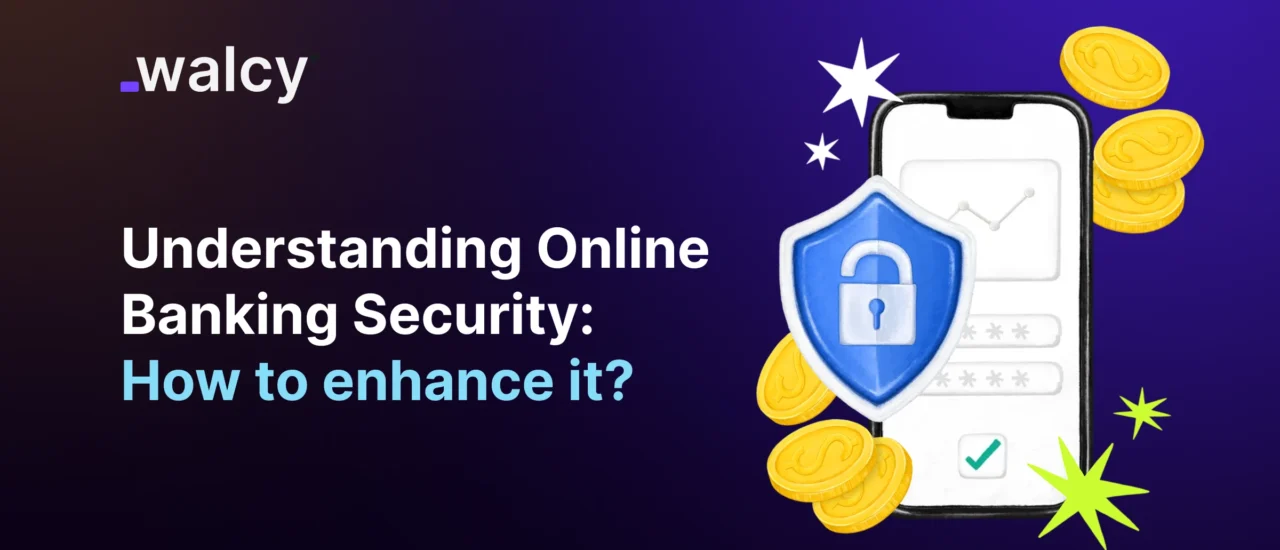Online banking has brought in a lot of convenience and has shifted us from the tedious processes of land-based traditional banking. It has redefined the way we handle our finances providing extraordinary ease and reach to carry out our monetary transactions. Yet, several drawbacks accompany digital banking: sophisticated cybercrimes against which online transaction fraud and then digital data security are the leading challenges of digital technology.
As per the figures for digital banking, in 2023 major bank regulators emphasized the immediate urgency for extremely safe and scrutinized strict approaches to be adopted toward their security measures.
Major online banking security practices will be explored in this blog article. It also provides key statistics on banking fraud in 2023 and how stakeholders within the digital banking ecosystem can protect themselves from various types of digital fraud. An attempt is made to discuss the steps banks can take to enhance their security.
Key Statistics on Bank Fraud in 2023
After the pandemic, the usage of online banking has surged, and naturally, there have been increasing banking fraud incidents. The techniques have become more sophisticated than ever, and hackers have exploited existing vulnerabilities within the online banking system. Here are some key statistics from 2023 that highlight the gravity of the situation:
Global Financial Losses Due to Banking Fraud:
According to a report by the Association of Certified Fraud Examiners (ACFE), global losses due to online banking fraud in 2023 were approximately an astounding $32 billion, a significant increase from $25 billion in 2022. This unexpected rise in banking fraud shows the growing volume of online transactions and the increase in the use of sophisticated fraud schemes.
New Fraud Techniques on the Rise:
Authorized Push Payment (APP) fraud has increased by a whopping 45%, as per the report by the European Payments Council (EPC). This fraud tricks the victim into authorizing payments to fraudsters. Similarly, phishing attacks, where a duplicate page is created to mimic the real app or webpage and steal credentials, increased by 28%. The techniques are more polished and refined, targeting not only individuals but also businesses and financial institutions.
Impact on Neobanks and Digital Wallets:
With the advent of neobanks and digital wallets, fraudsters have also exploited vulnerabilities in completely digital platforms. For instance, in 2023, neobanks and digital wallets were heavily targeted. According to some research, there was approximately a 70% increase in estimated fraud losses among neobanks. The fraud can be traced to their relatively new financial infrastructure and the complexities of digital security measures.
Know about: How Neobanks are Reshaping the Financial Landscape
Consumer Awareness and Impact:
Consumers’ vulnerability is high despite several layers of security, awareness campaigns, and fraud detection algorithms. Cybersecurity Ventures, in their consumer research, found that a significant chunk of online bankers in the U.S. suffered some form of cyber fraud in 2023. Furthermore, consumer perception towards online banking accounts showed that around 60% of users are concerned about the security of their online banking accounts. These statistics indicate that there is a lot of anxiety regarding potential cyber threats.
Advent of AI-Driven Frauds:
The AI boom has been a boon for many, simplifying and enhancing work and productivity. However, it has also led to new types of fraud. Using AI, fraudsters have automated and polished phishing campaigns. Deep social engineering techniques have been adopted in combination with deepfake techniques to trick bank employees and individual consumers into disclosing sensitive and confidential information.
The USA’s FBI’s Internet Crime Complaint Center (IC3) showed a 40% increase in such types of attacks, which presents a huge challenge, as these techniques will become more polished over time. Therefore, more sophisticated counter-measures must be developed.
These concerning statistics accentuate the judicious need for consolidated measures to mitigate online banking fraud and protect both consumers and financial institutions from escalating digital threats.
know more about: International Payment Fraud: Ultimate Guide For Businesses.
Mitigating Banking Fraud: What Are the Roles of Regulators, Neobanks, and Customers?
More than ever before, there is a significant increase in online banking fraud, and there needs to be a collaborative effort by all stakeholders involved in the online banking landscape to mitigate, prevent, protect, and enhance digital banking security.
Regulators’ Role in Banking Fraud:
Regulators play a critical role in setting and enforcing stringent standards strategically curated to address the needs of the time concerning online banking security. Some of the key measures regulators should consider as directives are:
Directives to Strengthen Cybersecurity Frameworks:
A comprehensive cybersecurity framework must be developed by regulators based on intelligence received from security researchers and experts. This framework will mandate banks and financial institutions to adopt best practices and become agile in adapting to the security framework. The directive should include regular and detailed security audits, risk assessments, continuous monitoring, and vulnerability and penetration testing to identify and address potential vulnerabilities and threats.
Platform for Real-Time Information Sharing:
Regulators must develop platforms for collective knowledge sharing in real-time about emerging and current threats, as well as newly discovered fraud mechanisms. Such collaborative platforms curated by regulatory bodies will allow banks and regulators to share threat intelligence, enhancing the overall security posture of the entire banking ecosystem. These platforms can also help other regulators develop contingency strategies.
Multi-Factor Authentication (MFA):
Regulators can require banks to mandatorily implement multi-factor authentication with inherence-based factors (e.g., biometrics, retina, DNA profile, or facial features) for all online transactions. This additional layer of security will deter unauthorized access to accounts, even if knowledge-based credentials are compromised.
Consumer Awareness Campaigns:
Regulators should run large-scale consumer awareness campaigns and embed cybersecurity-related educational content in school curricula to educate the public about common fraud tactics and inculcate safe online banking practices from an early age.
Neobank’s Role in Regulation:
Since neobanks operate on a digital-first principle, they are particularly vulnerable to a great deal of cyber threats. To protect themselves and their customers, neobanks should:
Robust Cybersecurity Infrastructure Based on Best Practices:
Many new neobanks in the fintech landscape disregard security best practices. Neobanks must invest in cybersecurity, use data protection standards, get certified, and include advanced threat detection systems like XDR and SIEM, encryption technologies, and 12-factor application development practices. After any feature update, the neobank should mandatorily perform penetration testing and, if possible, use third-party security assessments to identify vulnerabilities.
Behavioral Customer Authentication Methods:
There have been advancements in behavioral biometrics that analyze user behavior, such as typing speed, device orientation, location, usage time, and usage patterns, to detect anomalies. This helps neobanks move beyond traditional knowledge-based factors for authorization and authentication.
AI-Powered Fraud Detection Adoption:
AI-based sophisticated attacks are an emerging and significant threat for neobanks. Therefore, neobanks should leverage AI and advanced machine learning to detect and prevent fraud in real-time so that customers are not affected by digital fraud. These technologies can flag certain financial transactions and pass them to the cybercrime department for further investigation.
Role of Customers:
Since customers are largely part of the fraud lifecycle and most fraud activity stems from the customer, they should be the first line of defense against online banking fraud. Therefore, to protect themselves, they should:
Use Strong, Unique Passwords:
Customers should be mandated to create strong, unique passwords with wildcard characters for their online banking accounts and avoid recycling passwords across multiple platforms. Password managers like 1Password can help generate and store complex passwords seamlessly.
Enable Multi-Factor Authentication (MFA):
Enabling MFA adds an extra layer of security, and using inherence-based or possession-based methods will further enhance security.
Monitor Account Activity:
Customers should be notified to monitor their usage with a summary dashboard or a consolidated statement about bank statements and transactions. This will help them identify any suspicious or unauthorized activities missed by the fraud-detection system. They should immediately report any discrepancies to the bank to prevent further damage.
Awareness as a Service:
An awareness service within the web application or mobile app will inform customers about common scams, such as phishing, smishing (SMS phishing), and vishing (voice phishing). Emulation of such attacks and a real-time simulation facility will make users aware of how sophisticated the attacks can be and how vulnerable they are, ultimately enhancing their security mindset.
Avoid Public Wi-Fi and Use Antivirus:
Customers should be advised to use antivirus or anti-malware systems on their devices, ensure their operating systems are up-to-date, and avoid public Wi-Fi networks when accessing sensitive banking information.
By adhering to the shared responsibility principle, regulators, neobanks, and customers can work together to ensure a more secure online banking environment.
Read about: Digital Identity Management | Why is it Imperative?
How Banks Can Enhance Their Security
While creating collaboration among regulators, neobanks, and customers is vital, conventional banks themselves must also take decisive action to improve their own online security measures. Here are several strategies banks can adopt:
Strengthen Encryption and Data Protection Measures:
Data encryption, security incident reporting and management, data recovery measures, and time-to-recovery metrics are essential for protecting sensitive information from unauthorized access. Banks should:
End-to-End Encryption:
All data transmitted between banks and their customers should be encrypted to prevent man-in-the-middle attacks by hackers. End-to-end encryption, such as mutual transport layer security and hashing algorithms, ensures that only the intended recipient of the information can decrypt and access the data.
Secure APIs:
Neobanks heavily rely on third-party fintech service providers. Therefore, they must secure their API endpoints and ensure their service providers’ APIs are also secure to prevent unauthorized access and data breaches. JWT tokens and token exchange principles can largely help secure APIs.
Implement XDR and SIEM Applications:
Outdated software and systems are common points of vulnerability. Banks should have a methodical patch management process to ensure all systems are up-to-date with the latest security patches and updates. XDR provides a unified, holistic view of the overall security posture for the company, and SIEM provides insights into security events and logs.
Enhance Employee Training and Awareness:
Employees or people in an organization are often considered the weakest link in the security chain.
Regular Security Training for Employees:
Banks should conduct regular training to help employees recognize and respond to phishing attempts, social engineering schemes, and other forms of digital fraud. Simulated phishing attacks should be conducted to test and improve employee awareness.
Clear and Stringent Security Policies:
All banks should have clear security policies and procedures regarding data protection, incident response, and fraud prevention based on threat intelligence, regulatory directives, and industry best practices. These policies should be regularly reviewed and updated to reflect emerging threats and industry best practices.
Incident Response Plan:
Despite best efforts, no security system is infallible. Banks must be prepared to respond swiftly to any security incidents:
Incident Response Team:
A dedicated team of cybersecurity experts or DevSecOps professionals should be proactive and reactive in responding to security incidents. Banks should have clear protocols for identifying, containing, and mitigating threats under the team’s scrutiny and recommendations.
Regularly Test Response Plan:
Incident response plans should be tested regularly via simulated incidents and drills to ensure they are akin to muscle memory. Feedback and lessons learned from these simulations should be used to improve the plan continuously.
Collaborate with Industry Partners:
Participating in Information Sharing Networks such as the Financial Services Information Sharing and Analysis Center (FS-ISAC) helps with the seamless exchange of threat intelligence, industry best practices, and strategies for mitigating cyber risks. Furthermore, building strong relationships with law enforcement agencies can help banks respond more effectively to cyber threats and coordinate efforts to bring cybercriminals to justice.
Conclusion
Online banking security is a never-ending metamorphosis and the risks are growing on the run persistently so high with sophistication. In 2023 fraud attempts are more frequent plus sophisticated, making use of new technologies and techniques. To fight these threats, everyone needs to play a part regulators, neobanks, customers plus traditional banks. Firstly, stronger cybersecurity mandates and the facilitation of information sharing on potential threats by regulators.
Secondly, let neobanks invest in robust security but also have a duty to ensure that their customers are educated on online safety. Thirdly, the customers themselves being proactive by having strong passwords, activating multi-factor authentication, and staying up-to-date on common scams.
Lastly, traditional banks have a crucial role in enhancing their security measures by adopting advanced authentication methods, leveraging AI and machine learning, and ensuring robust encryption and data protection. By taking these steps, the financial industry can work towards creating a safer online banking environment that protects both consumers and institutions from the ever-growing threat of cybercrime.
Do follow us on Facebook and LinkedIn, to stay connected with us.



